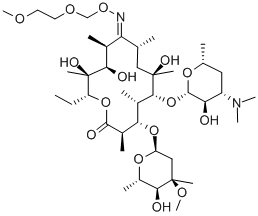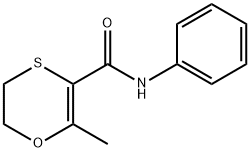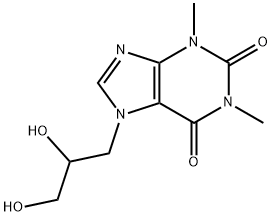
80214-83-1
- Product Name:Roxithromycin
- Molecular Formula:C41H76N2O15
- Purity:99%
- Molecular Weight:837.05
Product Details:
CasNo: 80214-83-1
Molecular Formula: C41H76N2O15
Purity: 99%
Synonyms: ERYTHROMYCIN 9-(-O-[2-METHOXYETHOXY]METHYLOXIME); ERYTHROMYCIN, 9-[O-[(2-METHOXYETHOXY)METHYL]OXIME], (9E)-; (9E)-9-[O-[(2-Methoxyethoxy)methyl]oxime] Erythromycin
Melting point: 111-118ºC
Boiling point: 864.7±75.0 °C
Alpha: D25 -77.5 ±2° (c = 0.45 in chloroform)
Density: 1.25±0.1 g/cm3
Fp: >110° (230°F)
Solubility: Chloroform: soluble 10mg/mL
Form: Powder
Color: White to off-White
Pharmacological effects:
Roxithromycin is a semi-synthetic 14-membered ring macrolide antibiotic. It has similar mechanism of action as erythromycin with its antibacterial effect in vivo being 1-4 times stronger than erythromycin. Its effect against Gram-positive bacteria is slightly worse than erythromycin; the effect against Legionella pneumophila is somehow stronger than erythromycin; for Chlamydia pneumoniae, Mycoplasma pneumoniae and Ureaplasma urealyticum, it has similar or slightly stronger antimicrobial effect compared with erythromycin.
This product can penetrate through the bacterial cell membrane, having reversible binding to bacterial ribosomes 50S subunit at close to the donor ("P" position), blocking the transfer of ribonucleic acid binding to the "P" position as well as blocking the transfer of the peptide chain from the acceptor position ("A" position) to "P" position, thus leading to the inhibition of bacterial protein synthesis and playing an antibacterial effect. It is characterized by faster access to macrophages, alveolar cells and neutrophils. In vitro studies have shown that roxithromycin has broad antibacterial spectrum with similar effect as erythromycin against a variety of Streptococcus (including A, B, C-type streptococcus and Streptococcus pneumoniae, but except G-type and enterococci), Streptococcus pneumoniae, Staphylococcus aureus, Staphylococcus aureus (except MRSA), Staphylococcus epidermidis, Legionella pneumophila, Haemophilus ducreyi, Chlamydia trachomatis, Mycoplasma pneumoniae and oral or vaginal anaerobic bacteria. Neisseria catarrhalis is highly sensitive to roxithromycin. It also has inhibitory effects on Campylobacter, Bordetella pertussis, Haemophilus influenzae, Mycobacterium tuberculosis and Diphtheria bacilli but has no antibacterial activity against other gram-negative bacteria. The in vivo antibacterial activity of this product was significantly stronger than that of erythromycin. It also has significant effect against chlamydia, mycoplasma, ureaplasma urealyticum, Treponema pallidum and Legionella infection. It also has relatively weak effect on the helicobacter, Neisseria gonorrhoeae, meningococcal and Bordetella pertussis. Some bacteria have cross-resistance to erythromycin and this product.
Indications:
This product is applicable to the purulent Streptococcus caused pharyngitis and tonsillitis, susceptible bacteria-caused sinusitis, otitis media, acute bronchitis, acute exacerbation of chronic bronchitis, Mycoplasma pneumoniae or Chlamydia pneumoniae caused pneumonia; Chlamydia trachomatis caused urinary reproductive system infections (urethritis and cervicitis); sensitive bacteria caused infection of skin soft tissue and other parts of the body; it can also used for non-specific and gonococcal genital infection, Legionella caused infection and Pediatric Infections.
Roxithromycin is characterized by acid resistance and excellent oral absorption with T1/2 being 12 to 14 hours which is 6 times higher than erythromycin. It has wide distribution in the body and is able to reach high concentration in both the upper and lower respiratory tract, reproductive tract and skin and maintain for a long time. Most of the metabolism occurs in vivo.
Roxithromycin clinical evaluation: the curing rate of chlamydia urethritis, cervicitis clinical and bacteriological was 93% to 97%; the efficacy against genital infection is similar to doxycycline; the cure rate for skin infection is 90% or more; the effectiveness for the treatment of respiratory infections is 83% and 50% while the effectiveness for the treatment of pneumonia and dental infections are 79% and 85%.
Uses:
It belongs to macrolide antibiotics, being a kind of erythromycin derivative with the antibacterial spectrum being similar as erythromycin but having a 6 times stronger effect on erythromycin with high bioavailability. It is used for the treatment of respiratory tract infection, such as pneumonia, acute bronchitis, acute infection of chronic bronchitis, atypical pneumonia, and genitourinary system infection, skin and soft tissue infections, having good therapeutic effect and tolerance with smaller adverse reactions than erythromycin.
The product belongs to a new generation of macrolide antibiotics, mainly used for Gram-positive bacteria, anaerobes, chlamydia and mycoplasma. Its antibacterial activity in vitro is similar as erythromycin with its in vivo effect being 1-4 times stronger than erythromycin. Pharmacological effects and indications
In clinical medicine, it is the first-choice drug for the treatment of drug-resistance Staphylococcus aureus and hemolytic streptococcus. In veterinary clinical practice, it is used for the treatment of penicillin-resistant staphylococcus aureus caused severe infection, pneumonia, uterine inflammation and poultry chronic respiratory disease.
The goods are mainly used for the treatment of livestock and poultry chronic respiratory disease with good efficacy in the treatment of livestock and poultry staphylococcus and streptococcal disease, chlamydia, spirocheal disease (swine dysentery), infectious pleurisy and rhinitis. Indications: avian neck swelling, local heat, pain, difficulty breathing, mouth and nose flow white foam, mucous membranes and skin cyanosis and other symptoms.
Relevant Products
-
Apixaban
CAS:503612-47-3
-
Carboxin
CAS:5234-68-4
-
Diprophylline
CAS:479-18-5








